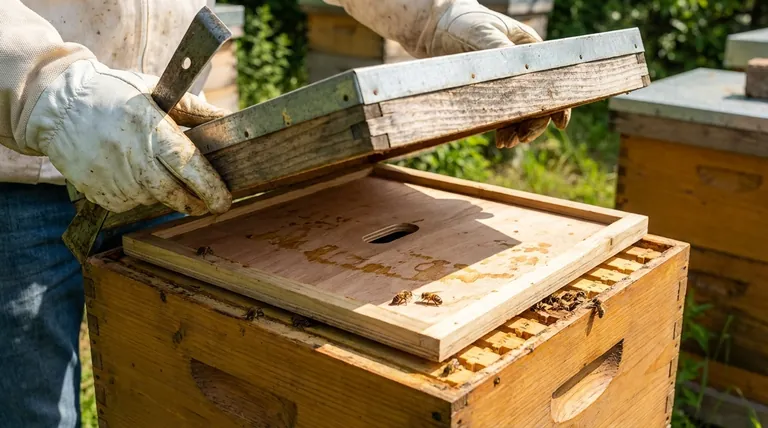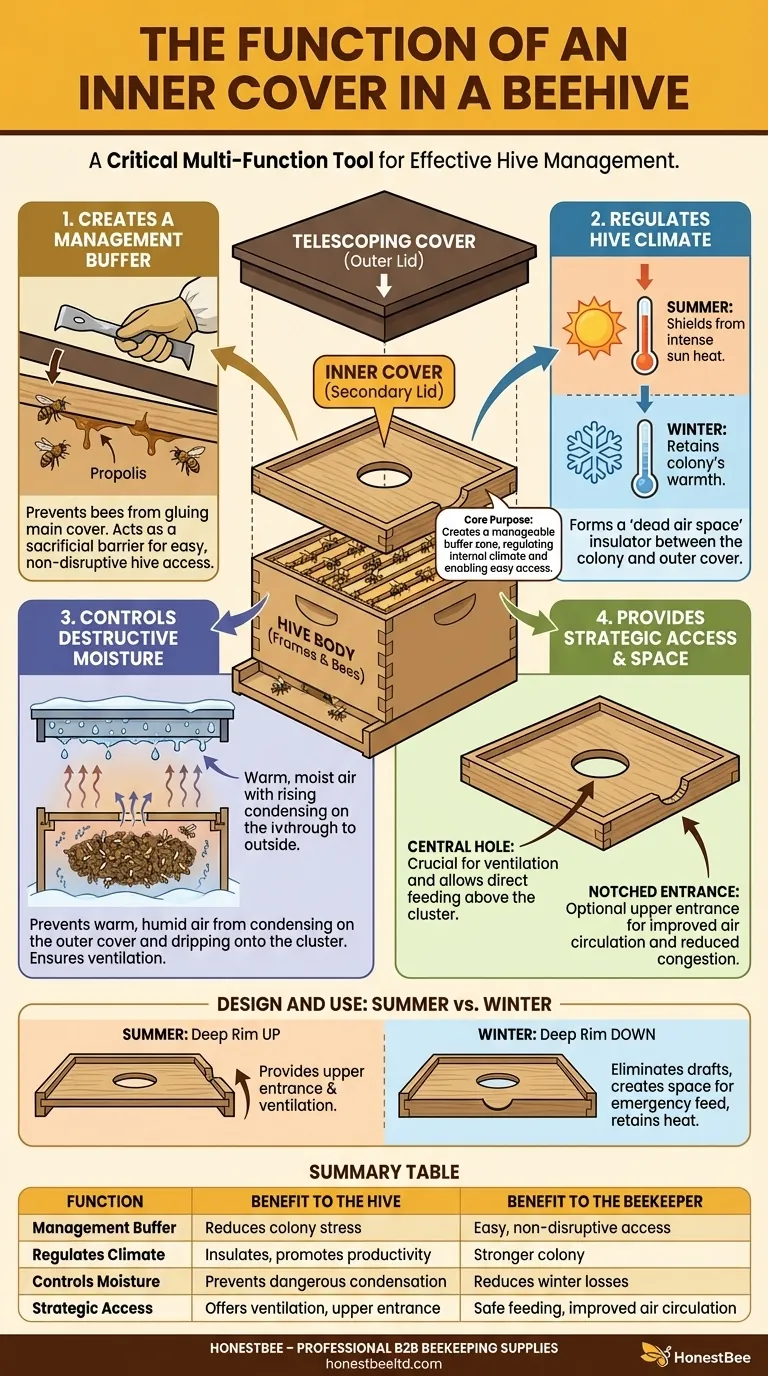In short, the inner cover is a critical multi-function tool for hive management. It serves as a secondary lid that sits below the main telescoping cover, providing essential insulation, ventilation, and moisture control while making hive inspections significantly easier for the beekeeper.
The core purpose of an inner cover is to create a manageable buffer zone between the colony and the outside world. This space is not empty; it's a vital tool the beekeeper uses to regulate the hive's internal climate and access the colony without causing massive disruption.

The Four Core Functions of an Inner Cover
A simple wooden board with a hole might seem insignificant, but its role is fundamental to the health of the colony and the practice of modern beekeeping. It solves several problems simultaneously.
It Creates a Management Buffer
Bees are master builders and will seal any unwanted gaps with a sticky substance called propolis.
Without an inner cover, they would firmly glue the main outer cover directly to the top box. This would make opening the hive for inspection extremely difficult, jarring the frames and agitating the entire colony.
The inner cover acts as a sacrificial, easily removable barrier. The bees glue it down instead, but a hive tool can break this seal with minimal disruption, allowing smooth access.
It Regulates the Hive Climate
The inner cover creates a pocket of dead air space between the colony and the outer cover.
This air space acts as an insulator, much like the space between two panes of glass in a double-glazed window. It shields the hive from the intense heat of direct sun on the outer cover in summer and helps retain the colony's warmth during winter.
It Controls Destructive Moisture
In winter, a cluster of bees generates significant warmth and moisture. When this warm, humid air rises and hits a cold outer cover, it condenses into water droplets.
This "rain" can drip down onto the cluster, chilling and killing the bees. The inner cover's air gap and central hole allow this moisture to ventilate or condense away from the bees, keeping the cluster dry and healthy.
It Provides Strategic Access and Space
The inner cover is designed with two key features for hive management.
First, it has a central hole. This is crucial for ventilation and serves as the access point for certain types of feeders, allowing you to feed the colony directly above the cluster.
Second, the rim often has a notched entrance. This can be used as an optional upper entrance for the bees, which improves air circulation and reduces traffic congestion at the hive's main bottom entrance.
Understanding the Design and Use
Properly using the inner cover's features is key to unlocking its full potential, particularly as the seasons change.
The "Summer" vs. "Winter" Side
Most inner covers have a rim that is deeper on one side than the other.
In summer, the cover is typically placed with the deep rim facing up. This positions the notched entrance to provide ventilation and an extra exit for foraging bees.
In winter, the cover is often flipped so the deep rim faces down. This eliminates the drafty upper entrance while creating a shallow space above the frames where you can place emergency sugar feed.
Why the Central Hole is Key
The central hole is non-negotiable. It is the primary exhaust vent for moisture and heat.
Many beekeepers place an empty shallow box (or an eke) over the hole in winter, filled with insulating material like straw or wood shavings. This absorbs moisture while still allowing some air exchange, creating a "quilt box" effect that keeps the colony dry.
How to Use Your Inner Cover Effectively
Your approach to the inner cover should adapt to the colony's needs throughout the year.
- For routine hive inspections: Your inner cover makes it possible to open the hive with minimal disturbance by preventing the outer lid from being glued down.
- During hot summer months: Place the cover with the notched rim accessible to provide an upper entrance for ventilation and to reduce traffic at the main entrance.
- When feeding the colony: Use the central hole to place a feeder directly above the cluster, ensuring easy and safe access for the bees.
- For winter preparation: Flip the cover so the deeper rim faces down. This contains heat better and provides a space for emergency sugar feed, while the central hole continues to vent excess moisture.
Mastering the use of the inner cover is a fundamental step from simply keeping bees to truly managing a healthy, productive colony.
Summary Table:
| Function | Benefit to the Hive | Benefit to the Beekeeper |
|---|---|---|
| Creates a Management Buffer | Reduces colony stress during inspections. | Allows for easy, non-disruptive hive access. |
| Regulates Hive Climate | Insulates from summer heat and retains winter warmth. | Promotes a stronger, more productive colony. |
| Controls Moisture | Prevents dangerous condensation from dripping on bees. | Reduces winter colony losses. |
| Provides Strategic Access | Offers ventilation and an optional upper entrance. | Enables safe feeding and improved air circulation. |
Ready to enhance your hive management with professional-grade equipment?
As HONESTBEE, we specialize in supplying durable, well-designed beekeeping supplies and equipment to commercial apiaries and distributors through our wholesale-focused operations. A high-quality inner cover is a cornerstone of effective hive management.
Contact our wholesale team today to discuss your needs and discover how our products can support the health of your colonies and the efficiency of your operation.
Visual Guide

Related Products
- Inner Beehive Cover for Beekeeping Bee Hive Inner Cover
- Professional Insulated Winter Hive Wrap for Beekeeping
- Stainless Steel Round Beehive Air Vents for Ventilation
- Professional Insulated Plastic Bee Hives
- Professional Galvanized Hive Strap with Secure Locking Buckle for Beekeeping
People Also Ask
- What is the function of the center hole in the inner cover? Master Hive Ventilation and Feeding
- What is the role of inner covers in insulated beehives? Master Moisture Control for a Healthy Colony
- What is the recommended orientation for the rim of an inner cover? Master Hive Ventilation and Insulation
- What is the role of the inner cover in a beehive? Essential Climate Control for Hive Health
- How is the inner cover used to promote ventilation? Master Hive Climate Control for Healthy Bees



















